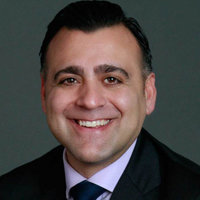Big TV Groups March Toward IP, Cloud Platforms
Major station groups are already far along in the transition to IP and are increasingly looking to the cloud for future investment, according to top technology executives speaking at TVNewsCheck’s TV2025 conference last week. They are also working closely with traditional broadcast vendors to guide their product roadmaps as big players from the IT and digital markets eye their turf.
Executives from Sinclair Broadcast Group, Tegna, Hearst Television and Fox Corp. said their stations have already virtualized many functions by moving them from dedicated systems to common off-the-shelf (COTS) hardware, and some are starting to replace aging HD-SDI infrastructures with IP routing. They already use the cloud for key applications, including distribution of OTT and diginet programming, and now plan to broaden their use of the cloud to support their main linear programming through a mix of public and private platforms.
Tegna moved back-office functions like payroll to the cloud years ago and launched its OTT programming services on the public cloud using Amazon Web Services (AWS) under the control of Amagi software. The company is now building a private cloud hub in Charlotte, N.C. to handle master-control functions, including content ingest and playout, for all of its stations.

Kurt Rao
According to Tegna CTO Kurt Rao, the public cloud works well for variable workflows like feeding OTT programming on an on-demand basis. But fixed workflows like linear playout are better served by a private cloud model.
“When I think of our linear broadcast that is 24/7 and running all the time, our economics show that a private cloud is much better than a public cloud,” said Rao, who was speaking on the panel “IP & The Cloud: A Roadmap for Future Revenue Opportunities,” moderated by this reporter.
Hearst Television already runs a number of applications in the cloud, using both the AWS and Microsoft Azure public platforms as well as its own private cloud. The group hasn’t addressed cloud-based playback yet but that is next on its roadmap, said Al Lustgarten, SVP of technology and information services for Hearst.
As for the overall transition to IP, the Hearst stations are “fairly far along,” he said, and have already moved most core functions and workflows to IP. The last big piece of the puzzle is SMPTE 2110 routing.

Al Lustgarten
“The last obstacle to tackle is just the pure routing of real-time video over IP, and that’s on our roadmap for 2021,” Lustgarten said. “We’re working on our infrastructure to support that and looking at a spine-leaf technology. We’re assessing our options for platforms to accomplish that and addressing issues like security and PTP [Precision Time Protocol] as we go along.”
Half of the Fox Television Stations have already virtualized key functions, with the goal to have the rest of the stations online by the end of the fiscal year, said Paul Capizzi, CIO and SVP technology for Fox Corp. The FTS group is also starting to invest in IP routing, and is launching an all-IP facility at WTTG Washington early next year with plans to roll out IP routing across more stations through 2021.

Paul Capizzi
As the Fox network builds out a new broadcast center in Tempe, Ariz., working with AWS to incorporate its technology both on-premise and in the public cloud, the Fox station group is also looking at changing existing workflows at its facilities.
“We’re constantly going to challenge ourselves and look at solutions that we currently do at the local stations and move them to Tempe,” Capizzi said. “Or even move them to the [public] cloud. We mentioned AWS with storage — maybe we should fully transcode our content in the cloud, no more on-prem. We’ve already taken steps in that direction.”
Sinclair moved to virtualization over five years ago, signing a long-term deal with Avid to virtualize its news production software across all of its stations. In 2017, Sinclair first experimented with using the public cloud to playout programming, originating its “KidsClick” children’s programming block from the Azure cloud under the control of Imagine software. It did that successfully for a year-and-a-half before shutting down the KidsClick service for business reasons.
Now Sinclair has taken another big step, last month launching distribution of all of its diginets from the AWS cloud, again using Imagine software. And the company is currently working with Encompass to build out a private-cloud playout hub for its regional sports networks in Atlanta as it looks to expand its overall use of cloud technology.
“I think all of our operations are going to move to the cloud in the next three to five years for sure,” said Del Parks, EVP and CTO of Sinclair Broadcast Group. “It just makes sense.”

Del Parks
Sinclair has invested in IP routing for its sports properties, building a large new 2110, 4K-capable facility in Los Angeles as well as 2110 facilities for regional sports networks in Chicago and Tampa, Fla. Parks said that’s because he expects professional sports will largely move to 4K UHD in the next three to five years. But he isn’t sure that Sinclair will invest in IP routing at its broadcast stations, as he is skeptical that local news production will go 4K. Parks thinks that stations will be well-served by the 1080p/60 HDR format, which can be supported by existing 3-gigabit HD-SDI routers at most stations.
The panelists noted both that their relationships with traditional vendors have changed and that they are working with new vendors as the industry moves to IP and cloud. Lustgarten has been buying equipment from big IT vendors like Cisco and HPE for years, but he sees fresh interest in the media space from those companies as they see a big opportunity in IP switching.
“The hounds have definitely gotten the scent, and they know there’s a big opportunity in media as we start to transition our systems,” Lustgarten said. “A lot of the major vendors are devoting time to media, and they’re starting to get traction in the media space.”
Parks noted that traditional vendors are being forced to rewrite their software to make it work with cloud platforms, while at the same time big cloud providers like AWS, Google and Microsoft are “chomping at the bit” to step in and fill any product voids. He said it is up to broadcast technology executives to work hand in hand with longtime vendors to help guide their product development. (Parks is doing his part, chairing Grass Valley’s GVX customer council.)
“That’s where we have to help our vendors,” Parks said. “If we want them to be in business, we have to help our vendors see where we want to go so they don’t waste their money building products that we don’t need.”
Read more TV2025 coverage here.
































Comments (0)